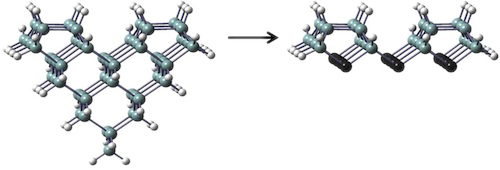Designer Atoms
One of the major considerations in implementing hybrid methods is the treatment of regional boundaries resulting from truncation of covalent bonds. The most common method for satisfying the resulting valence deficiency from cutting across bonds is to cap these dangling bonds with hydrogens. This leads to deficiencies in systems (e.g., oxides) where there is a significant electronegativity difference between the elements. Additionally, it leads to large errors in many problems involving materials chemistry (e.g., Si(100) surface) where multiple bonds to the same element are cut between layers. A better approach, leading to a nominal increase in cost, is to parameterize a set of pseudopotentials for these link atoms. A systematic development of such pseudoatoms (designer atoms) is being carried out to solve a range of problems in materials chemistry.
An example involving pseudo-silicon atoms resulting in significantly more efficient cluster models is shown.


